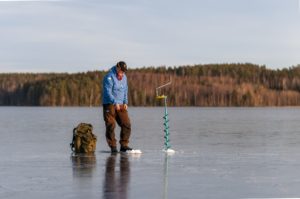Once a more niche form of fishing, ice fishing has been slowly but steadily growing in popularity, thanks to advances in modern technology, as it has allowed more and more people to keep comfortable while they sit out in the cold as they fish.
For people who are more used to the conventional way of fishing, ice fishing might seem odd, especially if this is the first time that they are hearing of it, but what is it about exactly?
What is ice fishing?
Like other forms of fishing, ice fishing involves using rods, lines, or spears to catch fish, but with a catch.
Instead of fishing someplace like a dock or the side of a river, you stand on top of a body of water (frozen of course), drill a hole, and throw your line in there.
True to the name, the body of water needs to be frozen over so that ice fishing may be attempted, and this can only really happen during the winter season.
It is not uncommon for anglers to drill multiple holes in the ice to find the perfect spot where the fish may appear. It saves time, as it means that anglers will be able to spot where fish appear much faster, and adjust their fishing spots accordingly, rather than wait for them to appear under the one spot they drilled.
But if you want to get right down to it, ice fishing is really as simple as making a single hole on the ice, preparing your rod, and sitting on a stool while waiting for the fish to bite.
There are those who may construct a house on top of a fishing hole. This process is called darkhouse fishing. For other anglers who may want access to other forms of entertainment, they can even get satellite TV while waiting for the fish to bite.
When was it invented?
Ice fishing supposedly dates back to over 2000 years ago. In comparison to today, where ice fishing is mostly done for sport, ice fishing in the past was likely done by our ancestors for survival, as the cold limited the food resources available to them. Instead of rods, people used spears to harpoon any fish that swam by.
Ever since then, ice fishing has slowly evolved to become more comfortable in the modern age. Drilling a hole in the ice is made easier and doesn’t require you to chop a hole in the ice like it did back then, plus we have all the modern luxuries to keep us comfortable while waiting for the fish to bite.
How dangerous is it?
The danger from ice fishing comes from the same environmental risks that the winter season brings in. That is, most of it is the cold temperature affecting your body, especially if you aren’t properly dressed to handle it.
Fishing on top of the ice also has its own risks. Just because a body of water is frozen over doesn’t mean that it is safe. It’s not easily discernable just how thick a sheet of ice that covers the top of a body of water is, and if the ice sheet is too thin, it can be easily destroyed by someone trying to step on it, causing them to fall into the freezing water.
Not only can this be dangerous to the body, as the cold temperature increases their chances of catching hypothermia, but the body of water may also be deep and be a potential cause for alarm if the person who fell does not know how to swim.
However, there are ways to mitigate this danger. First off, dress appropriately. This applies not just to ice fishing, but when you’re going out or doing any other winter activity. You want to keep your body warm and toasty no matter what to help you avoid hypothermia.
Next, don’t just walk onto a body of water that looks frozen over. At least, not without checking it out to make sure that it is safe. There is a rule of thumb to how thick the ice should be to ensure that it is safe to be crossed or walked over:
–4 inches minimum for people
–6 inches minimum for snow mobiles and sleds
–9 inches minimum for light cars
–12 inches minimum for heavy cars
–16 inches minimum for trucks and other large vehicles
Since you’re only going to be walking over the ice to fish, you only need 4 inches of ice. You can check how thick the ice is by piercing it with a spud bar or an auger and measuring it. Make sure you measure it on solid ground and not the body of water itself!
One additional thing: Moving bodies of water are terrible for forming thick ice, assuming ice even forms at the top. Rivers aren’t a good or safe choice for ice fishing, and you should steer clear from them.
Should I try it out?
For an angler who still wants to continue fishing despite the chilly weather and temperatures, ice fishing is a valid and recommended option.
While it is only really possible to do during the winter, it is an experience that you might want to have at least once, especially if you like winter fishing, so long as you ensure your safety. Falling in freezing water is unpleasant and potentially dangerous to your health, and we would rather that not happen in what should be a relaxing fishing trip.
Unfortunately, if you’re an angler in someplace else like a tropical country, ice fishing is all but impossible, as ice would never form on bodies of water to make ice fishing possible. If you ever visit a different country that has winter months and snow, and wish to try out ice fishing, it is most certainly recommended that you do so.
